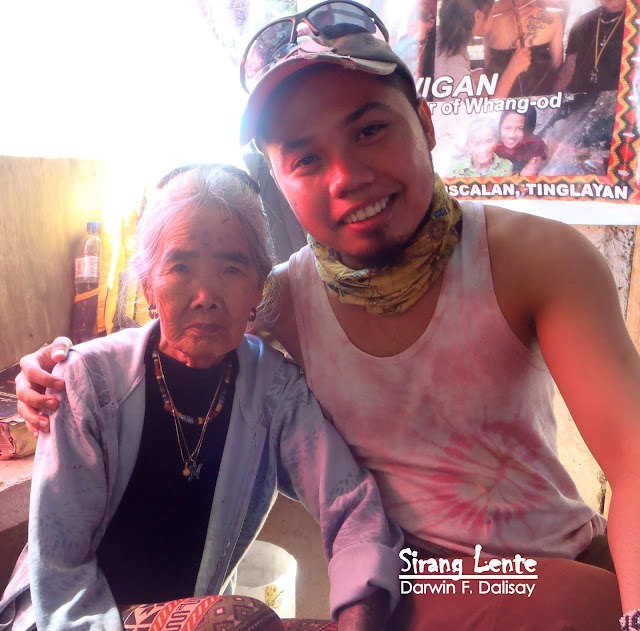
About Apo Whang Od
Deep in the mountains of Buscalan, Kalinga, lives Apo Whang-Od, the Philippines’ legendary mambabatok (traditional tattoo artist). At over a hundred years old, she continues the ancient art of hand-tapped tattoos, drawing visitors from around the world who seek not only her artistry but also a connection to Kalinga’s rich culture and heritage.
Our Journey to Kalinga

In this generation, most people think a tattoo has a negative connotation. It can even affect your career, regardless of the talent and education you may have. My eagerness to get inked started in October 2014 at the Philippine National Museum when I saw a portrait of an old lady with tribal tattoos all over her body. In National Geographic, several documentaries featured how significant tattoos and pierces were, especially for people in ancient times. Tattoos and pierces prove a tribe recognizes a person’s accomplishment, mostly in battles. There are several ways of tattooing worldwide, depending on their geographical feature and culture. In the Northern part of the Philippines, in Buscalan, Kalinga, they call it Batok. It is an ancient/tribal form of marking (tattooing) a warrior after successful combat, or a lady who brought pride to the tribe.

En route to Buscalan, I saw and stepped on one of the former 7 New Wonders of the World – Banaue Rice Terraces.

The village of the Butbut Tribe is surrounded by mountains, formed into rice terraces, for farming as their primary source of livelihood. Their older way of farming was already influenced by the modern way, like using a hand tractor to cultivate rice and vegetables. They also have a born-again Christian church, donated by the Koreans, and an elementary school, funded by the government. The ambiance in this village is really cool, the air is fresh, and the surroundings are relaxing, because of its geographical location.

At the village, one house captured my attention (photo above). As you can see, the terrace is surrounded by hanging bones, skulls, and teeth; they may be from wild animals hunted by the locals. Finally, it’s my time to be a warrior.
What to Expect in Kalinga
Traditional Tattooing
You can choose from centuries-old tribal patterns or smaller designs created by Whang-Od’s apprentices. Tattoos are done using a thorn, bamboo stick, and charcoal.
Meet Apo Whang-Od
While she continues to tattoo, she also trains her grandnieces, Grace and Elyang, ensuring the tradition lives on.
Community Immersion
Buscalan is a remote village—expect basic accommodations, cold weather, and no mobile signal. Visitors often stay in homestays arranged by locals.
Respect the Culture
Always be respectful—ask before taking photos, dress modestly, and support local products (coffee, handicrafts, souvenirs).
Apo Whang Od Tattoo
Apo Whang-Od’s tattoos are more than just body art—they are symbols of identity, bravery, and tradition. Using ancient batok techniques, her designs feature geometric patterns, tribal symbols, and nature-inspired motifs such as centipedes, rice patterns, and mountains, each carrying deep meaning rooted in Kalinga culture. Today, these timeless designs continue to honor the tribe’s heritage while attracting travelers who seek a lasting connection to the Philippines’ indigenous artistry.







The photo above was my tattoo after 24 hours. I’ve been part of show business for two years; meeting and talking to famous Philippine showbiz personalities and politicians is nothing more than meeting Apo Whang Od. I am now marked by the mighty hands of the National Living Treasure (legally, not yet). This mark means success and prosperity, perfect for the forthcoming Chinese New Year. Meeting and marked by Apo is already a success and prosperity for my future.
How to Get to Buscalan, Kalinga
Ride a bus bound for Bontoc (via Banaue or Sagada) or Tabuk (via Tuguegarao). Travel time is around 10–12 hours. Then, another jeepney ride to Tinglayan, about 1.5–2 hours away.
Summary
Meeting Apo Whang-Od is more than receiving a tattoo—it’s an encounter with living history and tradition. Through her artistry, she keeps the spirit of Kalinga alive, inspiring generations and preserving a cultural legacy that will forever be etched in Philippine identity.
Looking for travel ideas across the country? Read my complete guide to visiting all 82 provinces in the Philippines — based on my actual travels.

No comments:
Post a Comment
Enter Comment Below: